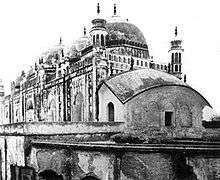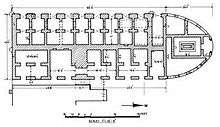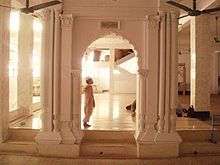Kartalab Khan Mosque
| Begum Bazar Mosque | |
|---|---|
| Basic information | |
| Location |
|
| Geographic coordinates | 23°43′01″N 90°23′55″E / 23.716944°N 90.398611°ECoordinates: 23°43′01″N 90°23′55″E / 23.716944°N 90.398611°E |
| Affiliation | Islam |
| Architectural description | |
| Architectural type | Mosque |
| Architectural style | Islamic architecture |
| Date established | 1701−04 |
Kartalab Khan Mosque or Begum Bazar Mosque situated in the Begum Bazar area in old Dhaka, Bangladesh, was built by Nawab Diwan Murshid Quli Khan alias Kartalab Khan in 1701–04. It is located beside the modern Jail of the city. The mosque consists of a high valuated platform, a mosque with a Dochala annex on the north upon the western half of the platform and a Baoli or stepped well to the east of the platform. Unlike the three-domed mosques at Lalbagh Fort and Atishkhana, that is, the Khan Mohammad Mridha Mosque, it is roofed over by five Bulbous domes resting on octagonal drums. The whole mosque was once reconstructed by the Jamider of Dhaka, Mirza Golam Pir. In accordance with Murshid Quli Khan's wishes, he was buried under the entrance to this mosque.

History
Kartalab Khan was appointed as Diwan or Revenue Administrator of Bengal by Emperor Aurangazeb, when Azim-ush-Shan was Viceroy. His original name was Murshid Quli Khan but he earned the title of Kartalab Khan from Emperor Aurangazwb for his efficiency in Revenue Administration. After coming to Bengal he erected a mosque at Dhaka, known after his name. Murshid Khuli Khan transferred the headquarters of the revenue administration from Dhaka to Mukshusabad, later on renamed Murshidabad in the year A.D. 1704 when a tussle started with the Subedar.

The Mosque is undoubtedly one of the most impressive Mughal structures of Dhaka, having been built on a high platform called Tahkhana. Underneath the platform there is a series of rectangular rooms that are let out to shopkeepers. A kitchen market was built to meet the expenses of the mosque. In 1777, the control of the market was taken over by Begum daughter of the then Naib-e-Nazim Sharfaraz Khan. The name of the locality ‘Begumbazar’ and the masjid originate from her name. The Baoli, the only known example of its kind in Bengal, is considered to be of North Indian or Deccan origin, the latter possibility being more likely since its builder had been in Deccen before coming to Dhaka.
Architectural Value
The mosque proper and the do-chala annex occupy the western half of the vaulted terrace. The remaining part of the terrace was originally kept open, but is now covered with a masonry verandah.
The mosque proper, inclusive of its corner towers, measures 28.65×8.23 m and is entered from the east through five arched doorways – each opens out under a half-dome and is flanked by slender octagonal turrets which rise above the parapets. There is one doorway in the middle of each of the north and south walls. The western wall is internally recessed with five semi-octagonal mihrabs, all showing outward projections with bordering turrets. There is a three-stepped masonry pulpit beside the central mihrab.

The interior of the mosque, forming a large elongated hall (25.60m by 5.18m), is divided into five bays by four transverse arches of plain four-centred design. The central bay is square and bigger than a couple of smaller rectangular ones on either side. All the bays are covered with domes on octagonal drums and crowned with lotus and kalasa finials. The device adopted for the support of the domes is the same as in the Lalbagh Fort mosque and the Satgumbad Mosque. The four octagonal corner towers, all rising above the horizontal parapets and having kalasa bases, are topped by renovated solid kiosks with copulas and finally crowned with lotus and kalasa finials. Each of these towers is again flanked to right and left by a slender turret, which rises above the parapet and ends in a small copula and kalasa finial.

The rectangular annex of the mosque in the north is covered with a Bengali type of do-chala hut roof, the eaves of which have pronounced curves and are drooping. The annex (6.10×2.13 m) has two doorways – one in the centre of the east wall, now renovated, and the other in the middle of the south side. It is through this latter opening that the annex and the mosque are interconnected. A window has been put in recently in the northern wall of the annex. Internally the four walls of the room are marked with rectangular and square deep niches, perhaps devised originally as shelves. The curved ridge is exterior crowned with five kalasa finials at intervals. This annex was thought to be a tomb, but probably it was originally meant for the Imam's accommodation since it is still used for that purpose.

In decorating the building greater emphasis was given to architectural elements, such as flanking ornamental turrets of the doorway and mihrab projections, kiosks, cupolas, and lotus and kalasa finials. The doorways and the mihrabs are framed, with crowning rows of merlons. The parapets and octagonal drums are also enriched with merlon motifs. The inside of the domes have basal leaf ornamentation, while there are large medallions containing a rosette motif in the centre. The half-domed vault of the central archway is ornamented with muqarnas work in stucco, now in a crude form. Save these, the entire building is covered with plain plaster, a distinguishing feature of Mughal architecture in Bengal.
The baoli of this mosque, which appears to be a monument by itself, deserves special mention. It is the only one of its kind in Bengal.
As stated by Dani,
The mosque proper also shows a departure from the earlier buildings. The older features of the three-domed mosque are here repeated and multiplied so as to make a five-domed mosque. The facade shows five entrance, each separated from the other by slender minaret rising high above the battlemented parapet. Similarly the corner towers have their kiosks shooting above.
Bibliography
- Mamoon, Muntasir. (1993). Dhaka-Smriti Bismritir Nogori. Dhaka: Anannya.(Page-182-183)
- Rahman, Mahbubur, The city of an architect
- Ahmed, Nazimuddin. 1984. Discover the monuments of Bangladesh. Dhaka: University Press Limited, 179.
- MA Bari, Kartalab Khan Mosque in Banglapedia
| Wikimedia Commons has media related to Kartalab Khan Mosque. |
_002.jpg)